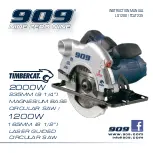
9
USING THE JIG SAW
First, secure the material in a bench vise or with clamps to the work table.
This is especially important when sawing small pieces or thin material. As
the work progresses in scroll or curved cut-out pieces, the material can be
re-adjusted to accommodate the movement of the saw. If the work is large
enough, it may be held only by hand across saw horses or some other rigid
support. The saw cuts freely with only light forward feed pressure on the
tool. Forcing the saw will not cause it to cut faster. Be careful not to twist the
saw while making the cut. This will cause blade breakage. To start the cut,
secure the work, mark the line of cut clearly, place forward edge of saw base
on edge of the material, start motor and when motor is up to desired speed,
move blade into the work.
NOTE:
Because of the variable speed feature, trial cuts at varying
speeds should be made on scrap material to determine the cutting
speed for the most desirable results.
DO NOT FORCE, LET THE SAW DO THE WORK.
Move saw forward only
fast enough to keep blade cutting. If cutting becomes difficult, the blade is
dull and should be changed at once. A dull blade not only makes cutting
more difficult but also overburdens the motor. You will find the open throat
and clear forward edge of the saw base make it easy to follow the line.































